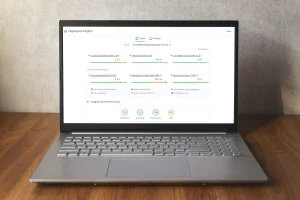
Web design trends 2025 are redefining how brands build experiences online, from speed and accessibility to immersion and personalization. In this guide, you’ll learn the must-have best website design practices for 2025, discover what’s fading, and see real-world strategies to future-proof your digital presence. Whether you lead a marketing team, run a startup, or manage an enterprise website, these insights will help you ship modern web design that converts and scales.
Why 2025 matters: user expectations, AI-driven experiences, privacy pressures, and new performance standards are converging. The result is a tipping point where website design choices directly influence revenue, SEO, and brand perception. Let’s break down what’s working now—and what will matter most in the year ahead.
Key takeaways you’ll get from this article:
- The 12 most impactful web design trends 2025 teams are shipping now
- Practical examples, tools, and design patterns you can apply
- Benchmarks for speed, accessibility, and conversion-focused UX
- A checklist for building modern web design that lasts
Design for People, Performance, and Purpose
Great website design in 2025 balances three pillars: user empathy, technical performance, and business outcomes. If your pages look gorgeous but load slowly, you’ll lose traffic. If your UI is fast but confusing, conversions stall. If your design wins awards but doesn’t map to clear goals, stakeholders lose trust.
The right mindset: prioritize user tasks, measure real outcomes, and architect for flexibility. The rest of these web design trends 2025 flow from that foundation.
Core Trend 1: Speed as a Design Feature
When it comes to modern web design, speed is no longer a developer-only metric—it’s a design outcome. Users expect instant feedback, snappy interactions, and content that loads in under two seconds on mobile. Google’s Core Web Vitals have crystallized this expectation.
What to do now:
– Optimize for Core Web Vitals: LCP under 2.5s, CLS minimal, and Interactivity/Responsiveness responsive across devices. See Google’s guidance at web.dev/vitals for specifics and measurement methods. (Outbound source: https://web.dev/vitals/)
– Embrace performance-first patterns: image CDNs, lazy loading, responsive images, prefetching critical routes, and lean component libraries.
– Choose modern stacks: static-first or hybrid SSR/ISR, headless CMS, and edge rendering can materially reduce latency.
Why this matters: Faster websites consistently see higher engagement and conversions. Treat performance as part of your best website design criteria—not an afterthought.
Core Trend 2: Accessibility and Inclusive UX as Non-Negotiables
Accessibility in web design trends 2025 moves from compliance to competitive advantage. Inclusive design improves usability for everyone and directly impacts SEO and reach.
What to prioritize:
- Semantic HTML, proper color contrast, and focus states that are clear and consistent.
- Keyboard and screen-reader-friendly navigation.
- Captions, transcripts, and descriptive alt text for media.
- Clear error states and accessible form design to prevent drop-offs.
Pro tip: Bake in accessibility during wireframing, not after launch. Modern web design teams audit early, test with real assistive tech, and add accessibility to their design QA checklist.
Core Trend 3: AI-Powered Personalization and Content Workflows
AI is reshaping website design—not just the visuals but the entire content lifecycle. The most successful implementations in 2025 use AI to enhance, not replace, human judgment.
Practical use cases:
- On-site personalization: adapt hero content, CTAs, or product recommendations based on behavior and context.
- AI-assisted content ops: generate first-draft descriptions, summarize long-form content, suggest SEO outlines, and tag assets automatically.
- Intelligent search: semantic search that understands natural language queries and intent.
Guardrails: always label AI-driven elements where relevant, respect privacy, and provide opt-outs. Prioritize accuracy and editorial standards to maintain brand trust.
Core Trend 4: Minimalism 2.0—Clarity with Personality
The clean, content-first aesthetic remains central to web design trends 2025, but it’s evolving. Expect minimalist layouts with distinct brand moments—bold color accents, expressive microinteractions, and meaningful motion.
Best practices:
- Use white space generously to guide attention and reduce cognitive load.
- Let typography do heavy lifting: variable fonts, strong hierarchy, and adaptive line lengths for readability.
- Add microinteractions that serve a purpose, like revealing context in product cards or confirming completed actions.
Avoid overusing gimmicks like heavy glassmorphism or excessive parallax. Keep delight—but keep it light.
Core Trend 5: Motion with Meaning, Not Motion for Motion’s Sake
Motion design is most effective when it communicates state, hierarchy, and cause-and-effect. In modern web design, animation should serve comprehension and speed perception.
Where to apply:
- Microinteractions: subtle button states, loaders that indicate step progress, and inline validations.
- Page transitions: quick, low-latency transitions that preserve continuity, especially in SPAs and multi-step flows.
- Data storytelling: animating charts or timelines to highlight insight, not just movement.
Keep it accessible: provide reduced-motion options and ensure animations don’t interfere with readability or performance.
Core Trend 6: Design Systems and Tokens for Scale
Scaling website design across products, regions, and teams requires more than a style guide. In 2025, robust design systems with design tokens are table stakes.
Core components:
- Tokenized values for color, spacing, typography, shadows, and motion.
- Reusable, accessible components with usage guidelines and code parity.
- Versioning and governance: document evolution, changelogs, and deprecation paths.
Outcomes: faster iterations, consistent UI, lower QA defects, and easier multi-brand orchestration. For many teams, this is the highest ROI investment in modern web design.
Core Trend 7: Data-Light 3D, AR, and Spatial UX
Immersive elements are maturing. The trend is not “more 3D everywhere,” but purposeful use where it helps users understand products or spaces.
Ideas to test:
- Lightweight 3D previews for product pages, optimized with mesh simplification and progressive loading.
- AR try-ons for retail and home goods, emphasizing accuracy and clarity over flashiness.
- Spatial navigation cues in complex dashboards, using depth and layering to signal relationships.
Rule of thumb: if it doesn’t improve comprehension or conversion, don’t ship it.
Core Trend 8: Content Design, Not Just Content
In web design trends 2025, content design is a strategic discipline. It shapes flows, reduces friction, and increases task success.
What good content design looks like:
- Clear, scannable, task-oriented copy. Short sentences. Front-load value.
- Structured content: headings, bullets, and components that adapt across channels.
- Evidence and specificity: numbers, timelines, and outcomes instead of vague claims.
Pair with UX writing standards. Consistency in voice and terminology reduces support tickets and boosts trust.
Core Trend 9: Privacy, Ethics, and Transparent Data Practices
Users are savvier about data. Regulations are evolving. Ethical website design decisions matter more than ever.
Design moves:
- Explain what you collect and why—in plain language. Avoid dark patterns in consent.
- Offer real controls: granular preferences, easy revocation, and stateful reminders.
- Minimize data by default. Track only what you use.
Result: higher opt-in rates, better-quality analytics, and a brand that feels trustworthy—crucial for conversions in 2025.
Core Trend 10: Sustainable Web Design and Green Performance
Modern web design isn’t only about speed. It’s also about reducing energy consumption and environmental impact.
Practical wins:
- Optimize media aggressively. Most page weight is images and video—compress, lazy load, and use modern formats.
- Reduce JavaScript payloads. Prefer native functionality and server-side logic when possible.
- Cache smartly. Edge caching and CDN strategies cut both latency and power use.
Measure what matters: total page weight, requests, and energy estimates. Sustainability also benefits mobile users on limited data plans.
Core Trend 11: Composable Architecture and Headless UX
Behind the scenes, many web design trends 2025 rely on composable architecture. Headless CMS, API-driven content, and modular components enable faster front-ends and omnichannel delivery.
Benefits to emphasize:
- Faster time-to-market for new pages and campaigns.
- Personalized experiences without heavy monoliths.
- Easier experimentation with A/B testing across templates.
Design for flexibility: your component library should cover 80% of use cases with sensible defaults—and allow extensions for the edge cases.
Core Trend 12: Human Support, Conversational UI, and Service Design
Digital experiences don’t end at the button click. Integrating human support and conversational UI completes the loop.
Where it fits:
- Proactive guidance in complex funnels (finance, healthcare, B2B SaaS).
- Conversational assistants for FAQs, account tasks, and onboarding.
- Clear paths to real humans: chat escalation, callbacks, and transparent SLAs.
Design the service journey end-to-end. Map moments of anxiety and provide empathetic, human-centered interventions.
Visual Trends You’ll Actually See on High-Performing Sites
Beyond the strategic shifts, here are visual and UI patterns emerging across web design trends 2025:
- Bold yet restrained color: one dominant brand color, a neutral base, and subtle gradients for depth.
- Variable typography: responsive type that adapts to device and context, with tight control over legibility and rhythm.
- Card-based layouts: predictable patterns that scale from mobile to desktop with a clear hierarchy.
- Soft shadows and layers: depth used to communicate interactivity and grouping—not to show off aesthetic flair.
- Tasteful dark mode: a thoughtful palette, true contrast, and brand-consistent accents.
- Real photography over stock: authenticity wins. When using illustrations, prefer simple, purposeful visuals over overly whimsical ones.
What’s Fading in 2025
Not all trends age well. Expect these to decline:
- Heavy, flashy effects that tank performance.
- Over-personalization that feels invasive or uncanny.
- Overlapping glassmorphism and neon blurs that harm readability.
- Long, scrolling “story” landing pages with no clear CTA.
Choose timeless clarity over short-lived novelty.
How to Apply These Web Design Trends 2025 Without Rebuilding Everything
You don’t need a ground-up redesign to benefit. Use a phased approach.
Step 1: Audit and Benchmark
- Measure Core Web Vitals, accessibility, and conversion by device.
- Map your top tasks and user journeys. Identify the biggest friction points.
Step 2: Quick Wins
- Optimize images and fonts. Clean up third-party scripts.
- Improve navigation clarity and inline help in forms.
- Tighten headings and CTAs. Remove vague copy.
Step 3: Systematize
- Introduce a basic design token set. Document components.
- Align cross-functional teams on naming, spacing, and content patterns.
Step 4: Enhance Experiences
- Add purposeful microinteractions and meaningful motion.
- Roll out conversational support where it reduces abandonment.
- Pilot personalization on one or two high-impact templates.
Step 5: Iterate with Evidence
- Run experiments with clear hypotheses.
- Report outcomes tied to business metrics, not just vanity metrics.
Real-World Examples and Benchmarks
Example 1: B2B SaaS Conversion Lift
- Problem: Pricing page confusion and slow mobile performance.
- Actions: Reduced JS by 35%, added table toggle for monthly/annual, clarified CTAs, and used progressive disclosure for FAQs.
- Result: 18% increase in trial starts and a 22% reduction in mobile bounce rate.
Example 2: Retail PDP Engagement
- Problem: High return rate due to poor product understanding.
- Actions: Added a lightweight 3D viewer and size guidance, improved alt text and captions, and introduced a short fit quiz.
- Result: 14% uplift in add-to-cart and 9% reduction in returns.
Example 3: Nonprofit Donation Flow
- Problem: Abandonment on step 2 of 3.
- Actions: Added trust indicators, simplified form fields, clear progress markers, and “save for later.”
- Result: 27% increase in completed donations and improved accessibility scores.
These outcomes come from applying the foundations: performance, clarity, and empathy.
SEO and Content Strategy for Modern Web Design
Your best website design in 2025 should work hand-in-hand with content and SEO.
Essentials:
- Search intent alignment: Map pages to informational, navigational, and transactional queries.
- Content components: FAQs, comparison tables, testimonials, and case studies built into templates.
- Structured data: FAQ, HowTo, Product, and Article schema where appropriate.
- Internal linking: Contextual links with descriptive anchor text to pass authority and guide users.
Remember: web design trends 2025 and modern web design choices affect how search engines crawl and render your pages. Clean architecture and fast rendering boost discoverability.
Governance, Testing, and Team Enablement
Good website design is a team sport. Make it repeatable.
Put this in place:
- Design QA checklist: accessibility, performance budgets, content QA, analytics validation.
- Component ownership: assign maintainers for critical elements.
- Usability testing: short monthly sessions with 5–7 users beat annual overhauls.
- Documentation hub: system guidelines, patterns, do/don’t examples, and code snippets.
When teams share a common language, quality scales.
Web Design Trends 2025 Checklist
Use this as a quick reference when planning or auditing your site:
- Performance
- Pages pass Core Web Vitals on mobile
- Media optimized (responsive images, modern formats)
- Lean, composable components with minimal JS
- Accessibility
- Semantic structure and proper contrast
- Keyboard navigation and screen reader support
- Clear focus states and error messaging
- UX and Visuals
- Clear information hierarchy and scannable content
- Purposeful motion with reduced-motion support
- Authentic visuals; minimal yet distinctive aesthetics
- Personalization and Content
- Non-intrusive personalization with privacy controls
- Strong content design and UX writing standards
- Schema markup and internal linking strategy
- Architecture and Ops
- Design tokens and documented components
- Headless or composable stack, where it adds value
- Ongoing usability testing and analytics reviews
Ready to Start Your Project?
Let's discuss your goals and create something amazing together. Our team is ready to help you achieve your digital objectives.
Let's Talk

